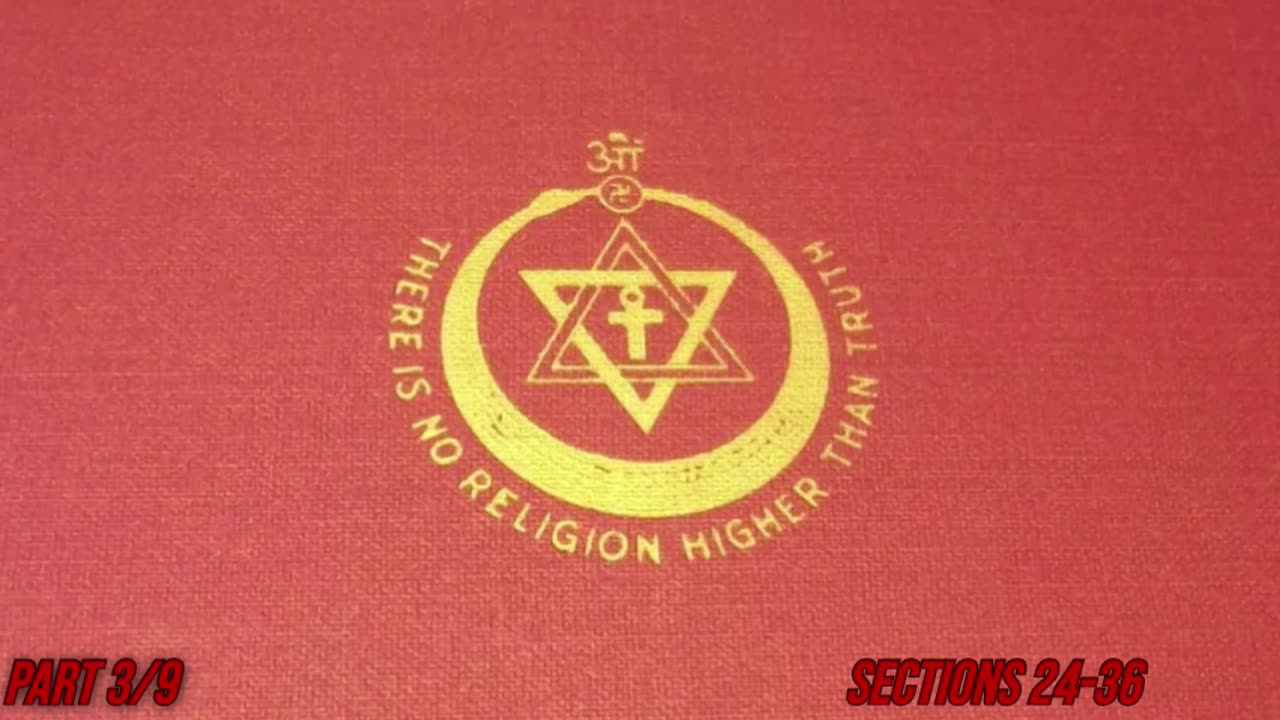Premium Only Content

The Secret Doctrine by Blavatsky Part 3/9 Sections 24-36
Part 3 (Sections 24-36) of "The Secret Doctrine" by Helena Petrovna Blavatsky shifts focus from the cosmic principles and metaphysical framework outlined in the earlier parts to explore the esoteric understanding of human evolution and the origins of humanity. This part is heavily centered on anthropogenesis, or the spiritual and physical evolution of humans according to ancient esoteric teachings. Blavatsky aims to present a hidden history of humanity that challenges conventional scientific and religious narratives, integrating occult teachings, mythology, and comparative religion.
Overview of Part 3:
In this part, Blavatsky discusses the evolution of human consciousness and the development of early races that predate known history. Her account of human origins is based on the Stanzas of Dzyan, which she continues to interpret and expand upon. Blavatsky describes a series of root races, which are stages in the spiritual and physical evolution of humanity, each representing a different phase in the development of human potential and consciousness.
Key Concepts and Sections in Part 3:
1. The Concept of Root Races:
A central focus of this part is the doctrine of the Seven Root Races, a concept drawn from esoteric traditions and theosophy. Blavatsky outlines that humanity progresses through a series of seven root races, each with seven sub-races, with each stage representing a phase in both physical evolution and spiritual development.
Previous Root Races: She describes the first two root races as etheric and astral, existing in a more spiritual form before humanity became physical. These beings were not bound by the material world in the same way as modern humans.
The Lemurian Race: The third root race, known as the Lemurians, is described as a transitional phase where humans began to develop physical bodies. Lemuria, according to Blavatsky, was a vast continent that existed in what is now the Pacific Ocean. The Lemurians were giants and are said to have possessed primitive intelligence but were still spiritually connected to higher planes.
The Atlantean Race: The fourth root race, Atlantis, is described as having advanced in technology and civilization but ultimately succumbing to their material desires and spiritual decline. The fall of Atlantis serves as a cautionary tale of the dangers of misusing knowledge and disregarding spiritual values.
2. The Role of the Divine Spark and Spiritual Hierarchies:
Blavatsky describes the descent of the divine spark into physical matter, a concept which parallels Gnostic and Hermetic ideas. According to her, higher spiritual beings, including Dhyani-Chohans and Manasaputras (sons of mind), helped to incarnate this divine essence into early humanity, giving rise to self-conscious thought and individuality.
This process represents the moment when spirit fully enters the material plane, allowing human beings to develop intellect and self-awareness.
3. Esoteric Anthropology and Alternative History:
Blavatsky critiques Darwinian evolution and materialist science, arguing that they do not account for the spiritual dimension of human evolution. She presents an alternative view, where human development is guided by spiritual hierarchies and cosmic laws rather than purely natural selection.
She claims that ancient texts such as Vedic scriptures, Zohar, and Kabbalistic writings preserve records of ancient civilizations and pre-Adamic races, suggesting that modern humanity is unaware of its true spiritual heritage.
4. The Concept of Karma and Reincarnation:
A critical aspect of Blavatsky’s teachings in this section is the role of karma and reincarnation in the evolution of humanity. She explains that the spiritual development of each root race is influenced by karmic cycles, with each race contributing to the cosmic balance through its experiences.
This idea ties into her belief in periodic rebirth, where the souls of humanity evolve over many lifetimes, each time gaining new spiritual insights and lessons.
5. Symbolism of Serpents, Dragons, and Mythological Figures:
Blavatsky uses symbolic language drawn from various mythological traditions to describe the spiritual descent of early humanity. Serpents and dragons are recurrent symbols, representing wisdom and occult knowledge. These symbols appear in myths across cultures, and Blavatsky interprets them as references to esoteric teachings about humanity's divine origins.
She draws parallels between Hindu Naga serpents, Gnostic symbolism, and Western mythologies, arguing that they all point to a hidden, esoteric understanding of human development.
Purpose of Part 3:
This section serves as a detailed exploration of the spiritual journey of humanity through various epochs. Blavatsky presents a cosmic narrative that emphasizes the interconnectedness of spirit and matter, and the evolution of consciousness.
It challenges readers to rethink conventional views of history and evolution, suggesting that ancient myths hold hidden truths that modern science has yet to understand.
Style and Presentation:
Blavatsky’s writing in this part remains dense and symbolic, with extensive references to ancient scriptures, mythological stories, and occult doctrines. She writes with an authoritative tone, presenting her ideas as a synthesis of ancient knowledge and esoteric wisdom.
The structure of Part 3 combines narrative commentary on the Stanzas of Dzyan with comparative analysis, where she juxtaposes her ideas against those found in Hindu texts, Platonic philosophy, and Christian mysticism.
Significance of Part 3:
Part 3 is significant for its exploration of anthropogenesis from an esoteric perspective, offering a vision of humanity as a spiritual entity undergoing transformation through various stages of material existence.
This section is particularly important to Theosophists and students of Western esotericism, as it provides a framework for understanding the evolution of the soul and its cosmic purpose.
ABOUT THE AUTHOR:
Helena Petrovna Blavatsky (1831-1891)
Helena Petrovna Blavatsky—often known simply as Madame Blavatsky or HPB—was a Russian occultist, mystic, and co-founder of the Theosophical Society, a movement that sought to reconcile spirituality with science and philosophy by drawing upon ancient esoteric traditions. Born on August 12, 1831, in Ekaterinoslav, then part of the Russian Empire (now Dnipro, Ukraine), she is widely considered one of the most influential figures in the modern esoteric and occult revival of the late 19th century. Her writings and teachings, particularly "Isis Unveiled" (1877) and "The Secret Doctrine" (1888), continue to shape New Age thought, Western esotericism, and spiritual movements to this day.
Early Life and Influences
Blavatsky was born into a noble Russian family, with her mother, Helena Andreyevna von Hahn, being a novelist and her father, Colonel Peter Hahn, serving in the Russian military. From a young age, she displayed an interest in the mystical and supernatural, with accounts of her life mentioning experiences with clairvoyance, telepathy, and astral travel. Her family's access to Western literature and philosophy exposed her to esoteric ideas early on, which she later developed into her own theosophical framework.
In her early adulthood, Blavatsky embarked on extensive travels that took her across Europe, the Middle East, India, and Tibet. During these journeys, she claimed to have studied with esoteric teachers and initiates, particularly in India and Tibet, who taught her the ancient wisdom traditions that would form the core of her later teachings.
Founding of the Theosophical Society
In 1875, Blavatsky co-founded the Theosophical Society in New York City with Henry Steel Olcott and William Quan Judge. The society aimed to:
1. Promote the study of comparative religion, philosophy, and science.
2. Investigate unexplained laws of nature and the powers latent in humanity.
3. Promote universal brotherhood, transcending distinctions of race, creed, sex, caste, or color.
The Theosophical Society played a pivotal role in introducing Eastern philosophies, such as Hinduism and Buddhism, to the Western world, promoting the idea that all religions contain an underlying spiritual truth. Blavatsky served as the spiritual head of the movement, positioning herself as a messenger for the hidden masters or Mahatmas, whom she claimed were enlightened beings guiding the spiritual evolution of humanity.
Key Works and Esoteric Teachings
"Isis Unveiled" (1877): Blavatsky’s first major work sought to challenge materialism and scientific reductionism, arguing that ancient wisdom held the keys to understanding spiritual phenomena and the hidden aspects of nature. The book covered a wide range of subjects, from mythology to comparative religion, psychic phenomena, and occult sciences.
"The Secret Doctrine" (1888): This two-volume work is considered her magnum opus. It lays out a cosmological vision based on the Stanzas of Dzyan, which she claimed were ancient texts from Tibet. The first volume, "Cosmogenesis", focuses on the origin of the universe and cosmic evolution, while the second volume, "Anthropogenesis", explores the esoteric history of humanity through the seven root races. Blavatsky aimed to provide a synthesis of science, religion, and philosophy, drawing upon Eastern mysticism, Hermeticism, and Kabbalistic traditions.
Affiliations with Secret Societies
Blavatsky’s life and work were deeply intertwined with the esoteric traditions and secret societies that she studied and promoted. While there is some ambiguity surrounding her precise affiliations, her connections to various mystical and occult orders are well-documented:
1. Freemasonry:
Blavatsky claimed connections with Freemasonry, particularly through Co-Freemasonry and esoteric branches of the craft that included women, which was unusual for traditional Freemasonry. She was associated with Rite of Adoption lodges, a branch of Continental Masonry that allowed female members.
Her writings often reflect a Masonic worldview, utilizing symbolism and concepts familiar to Masonic teachings, such as the spiritual significance of geometric shapes and initiatory practices.
2. Rosicrucianism:
Blavatsky’s teachings frequently align with Rosicrucian ideals, emphasizing the existence of a hidden knowledge that dates back to ancient Egypt, Hermeticism, and alchemical traditions. She often spoke of the Rosicrucians as being among the guardians of ancient wisdom.
While no direct records confirm her initiation into a formal Rosicrucian order, Blavatsky’s writings suggest a deep sympathy for Rosicrucian principles, particularly in her emphasis on spiritual alchemy and the transmutation of the soul.
3. Hermetic Brotherhood of Luxor:
Blavatsky’s early writings and teachings have connections to the Hermetic Brotherhood of Luxor, a 19th-century occult order that combined Egyptian mysteries with Western esotericism. Some sources suggest that she had correspondences with members of this brotherhood, sharing a common interest in ancient Egyptian mysticism.
The Hermetic principles she discusses in her writings, such as the Law of Correspondence ("As above, so below"), reflect the influence of Hermetic thought on her theosophical worldview.
4. Kabbalistic Traditions:
Blavatsky’s work is heavily influenced by Jewish Kabbalah, which she viewed as a repository of esoteric wisdom with roots in ancient Chaldean and Egyptian mysticism. She believed that Kabbalistic teachings were closely related to the mysteries of the East, drawing parallels between Kabbalistic concepts and Vedic philosophy.
Although not formally initiated into any Kabbalistic society, Blavatsky incorporated Kabbalistic symbols, such as the Sephiroth and the Tree of Life, into her interpretation of the cosmos and spiritual evolution.
Controversies and Criticisms
Blavatsky’s life and work were marked by significant controversy. She faced criticism and skepticism from the scientific community of her time, as well as from Christian missionaries who opposed her promotion of Eastern religions in the West. Her claims of communication with the Mahatmas were challenged by skeptics, most notably during the Hodgson Report published by the Society for Psychical Research in 1885, which accused her of being a charlatan. However, many of her followers continued to believe in her spiritual authority and the validity of her occult experiences.
Legacy and Impact
Blavatsky’s influence extends far beyond her lifetime, shaping the New Age movement, Western occult traditions, and esoteric schools of thought. Her emphasis on the unity of all religions, the divine nature of the cosmos, and the importance of spiritual evolution has had a profound impact on mystical traditions and philosophical inquiries into the nature of reality. The Theosophical Society she co-founded continues to have branches around the world, promoting the study of esoteric philosophy and spiritual science.
Helena Petrovna Blavatsky remains a polarizing figure—revered by many as a spiritual visionary and pioneer of esoteric thought, while criticized by others as a controversial mystic with unorthodox ideas. Regardless of perspective, her role in reshaping the Western spiritual landscape and bridging Eastern and Western philosophies is undeniable, making her a central figure in the history of modern esotericism.
-
 10:19:56
10:19:56
Deus Meum Que Jus
2 months agoOur Story of Atlantis, A Physician’s Adventure, ... (Full Title in Description)
806 -
 58:53
58:53
The White House
3 hours agoPress Secretary Karoline Leavitt Briefs Members of the Media, July 31, 2025
24.3K33 -
 5:48:07
5:48:07
JuicyJohns
7 hours ago $3.09 earned🟢#1 REBIRTH PLAYER 10.2+ KD🟢$500 GIVEAWAY SATURDAY!
74.4K3 -
 LIVE
LIVE
IrishBreakdown
3 hours agoNotre Dame Fall Camp Practice Report
61 watching -
 1:04:08
1:04:08
Timcast
3 hours agoPelosi MELTS DOWN After Trump Accuses Her Of INSIDER TADING, PELOSI ACT Moves Forward
152K83 -
 1:54:53
1:54:53
Steven Crowder
6 hours ago🔴 Is the Sig Sauer P320 Killing People & Trump Wins the Trade War: Guest Brandon Herrera
332K244 -
 1:09:57
1:09:57
Rebel News
2 hours agoCanada to recognize Palestine, US trade deadline looms, Charter-protected bike lanes | Rebel Roundup
25.8K11 -
 1:00:16
1:00:16
TheAlecLaceShow
3 hours agoGuest: Roger Stone | Kash Patel Finds Hoax Docs in Secret FBI Room | The Alec Lace Show
18.7K5 -
 1:43:37
1:43:37
The Rubin Report
4 hours agoWhy I’m Taking a Break
56.7K39 -
 1:36:22
1:36:22
The Mel K Show
4 hours agoMORNINGS WITH MEL K -Truth Tsunami Alert: Panic in DC! 7-31-25
33.6K13